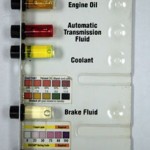Today's Car Care Tip: Tips for Getting Ready For Cold Weather
A lot of people ask me, 'Do I need to winterize my cooling system this year?' and 'How long should my antifreeze or coolant last?'Most people think that the only thing they need to worry about when it comes to their coolant is AVOIDING FREEZE-UPS.
There are 3 things we have to worry about with coolant:
- Protection against freezing and boiling
- Rust and Mineral Deposits
- pH balance
A 50-50 mix in Colorado gives protection to –34 degrees
Rust
Rust will grow in the system over time. It's a living entity that eats things.
pH Balance
Acid eats:
- Radiators
- Heater cores
- Hoses
- Engine head gaskets
- Mineral deposits
- Clogged up radiators, thermostats, and heater cores
A Radiator drain and fill doesn't really fix the big problems. The radiator will still have rust / pH Balance problems.
Every 2 Years, do a complete Cooling System Flush, including a Chemical Flush / Back-flush. This will remove rust and mineral deposits, and set the pH balance correctly.
This is some of the best insurance you can buy for your car this winter!
Handy Car Care Tips and Suggestions
- Used Car Buyers’ Checklist – Don’t buy a used car without running through this! These are the questions every used car buyer should ask.
- Going Green with your Car – How to go green with your car and reduce your carbon footprint!
- Fuel Saving Tips – Here are some easy ways to increase your gas mileage at home!
- Report A Pothole in the Denver area – If you’re sick of hitting the same pothole everyday, use one of these numbers to report a pothole in your area!
Fluid Colors
 These are what your vehicle’s fluids look like when they’re brand new and just added to your vehicle. If they’re black, smell burnt, or just past your manufacturer’s recommended service interval, getting these fluids changed can prevent big expenses down the road. Click here to see the fluid chart.
These are what your vehicle’s fluids look like when they’re brand new and just added to your vehicle. If they’re black, smell burnt, or just past your manufacturer’s recommended service interval, getting these fluids changed can prevent big expenses down the road. Click here to see the fluid chart.
Vehicle Systems
These are diagrams of how all of the integral systems in your car work. From your air conditioning, to your brakes, to your engine, use these diagrams to see how everything works, and why certain repairs and preventative maintenance services are necessary, and can save you money in the long run. Click on any picture below to see a larger diagram!











